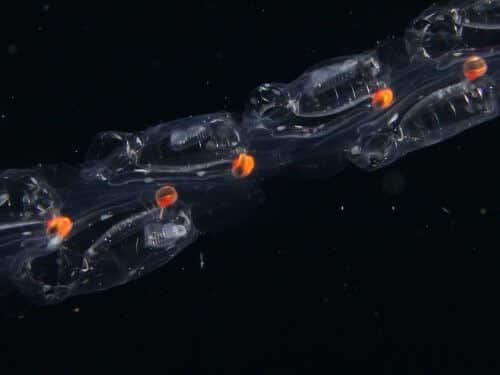A study conducted at the Technion and the University of Oregon explains for the first time the evolutionary logic in the movement of colonies of salpa - a small sea creature that swims vast distances every night

An article in the Journal of the Royal Society Interface explains for the first time the evolutionary logic behind the movement of colonies of salpa - a small marine creature that swims vast distances every night. The research was conducted at the Technion and the University of Oregon in the USA.
Salpida are a family of primitive marine creatures living in all oceans and some seas. Although it looks a bit like a jellyfish, it is actually a large plankton (several centimeters long) that feeds on smaller plankton creatures. The salpa can grow at an impressive speed and double its body length within an hour.
One of the salpa's unique characteristics is its two life stages: the first stage, in which the salpa lives alone and produces (genetically) identical offspring in asexual reproduction; And the second stage, in which she lives as part of a "chain colony" of creatures like her that maintain sexual reproduction. A single salpa is only a few centimeters long, but an entire colony may include hundreds of units and reach a length of up to 10 meters. Communities of such colonies sometimes cover hundreds of square kilometers.
The salpa colonies are found during the day at a depth of hundreds of meters, but every night they swim up towards the sea surface for nutrition and sexual reproduction. In these nocturnal journeys upwards and then back to the depths, the colonies hollow out a distance of hundreds of meters at an impressive speed - every second they travel a distance 10 times greater than their length. For comparison, the runner Usain Bolt - every second he glides a distance 5 times greater than his height, and unlike them, he does it for only a few seconds and not for a long time.
The salpa propels itself using a jet of water that it sends backwards. An interesting fact is that when the entire colony swims together, the jet firing is not coordinated; Each salpa fires at its own rate. This rhythm is dictated by the local "brain" on her back, which consists of motor neurons responsible for movement and rhythm neurons, which serve as a kind of pacemaker.

This uncoordinated movement aroused the curiosity of researchers from the Technion and the University of Oregon in the USA: Research Professor Danny Weiss from the Faculty of Aeronautics and Space Engineering at the Technion and Associate Professor Kelly Sutherland from the Faculty of Biology at the University of Oregon. The two built a theoretical model that explains the dynamics of the colony's movement, and tested it using video footage of these colonies. This is the first time that the salaf movement is examined quantitatively.
The researchers' conclusion was that the non-coordinated jet songs exact a certain price in terms of instantaneous speed but yield a great benefit in several aspects:
- uniform progress and not an alternating movement of jumping and stopping;
- reducing the mutual interference of the jets;
- A significant reduction in the force of drag - the force opposing the movement of bodies in a liquid.
"In fact, we discovered that the misalignment of the jets' firing creates a smooth velocity profile," explains Prof. Weiss. "In the case of a single salpa, the organism accelerates as a result of the firing and then slows down until the next firing; But in the group movement, since each jet is fired at a different time, a smooth movement of the entire colony is obtained. If the colony was moving while coordinating the timing of the jet firing, it would be a movement of acceleration-deceleration-acceleration and so on, a movement that creates a high drag that would delay the movement of the colony. It can be said that the uncoordinated dynamics allow the colony to run for long distances, and this is the evolutionary logic that led to the development of this movement pattern."
"What we did is basic science," says Associate Professor Sutherland, "but you can learn a lot from it - for example, in certain circumstances it is better for each individual in the group to do what he sees as right, or what he was programmed to do, and not for everyone to perform the same action at the same time. "
"The observations in the colony confirm the hydrodynamic model we predicted in the theoretical phase," says Prof. Weiss, "this is the first time that uncoordinated swimming has been examined in a quantitative study, and the findings may provide inspiration for the development of jet propulsion systems in underwater vessels."

3 תגובות
The title is wrong. The article does not explain the movement itself, but the asynchrony of the movement of the individuals in the colony.
It seems that the fast forward movement is intended to allow efficient "fishing" of plankton, but, when swimming in a column, the individual at the top of the column has an advantage over the individuals behind it. Therefore, since this is an organic colony, and the nutrition of all the individuals is essential for the survival of the colony, it is expected that the individuals will switch places during the "shift", so that every certain period of time the first ones will move back and turn the front to the others. I wonder if this prediction was actually observed?
In the selfie of the salafets, red dots are visible on the sides of their bows. Reminds me of "winkers" but only on one side.
Perhaps Fr. Danny Weiss, or someone else with knowledge on the subject, can explain the matter? Thanks.